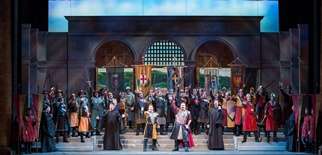|
Back
Sarasota Completes its Epic Verdi Cycle (Part I) Sarasota
Sarasota Opera
03/16/2016 - & March 18, 2016
Giuseppe Verdi: La battaglia di Legnano
Jennifer Black (Lida), Martin Nusspaumer (Arrigo), Todd Thomas (Rolando), Young Bok Kim (Frederico Barbarossa), Harold Wilson (Marcovaldo) and Tara Curtis (Imelda)
Sarasota Opera Apprentice and Studio Artists Chorus, Roger L. Bingaman (Chorus Master)
Sarasota Opera Orchestra, Victor DeRenzi (Conductor)

(© Rod Millington)
Florida’s Sarasota Opera claims that it is the only company on earth to have performed all of Verdi’s music—that is, everything that is available—from early songs, sacred music, to all 33 operas (including revised versions). Since 1989 the company has been chalking up the statistics each season with productions ranging from seldom-performed operas, such as Jérusalem and Un giorno di regno (which were great crowd pleasers), to early sacred works such as Tantum Ergo and Momento Domine David—Psalm 131, to orchestral pieces such as various Sinfonia, and to 10 available measures of a piano work entitled Piano piece in 6/8. The 2016 winter season (which is running from early January to late March) concludes the 28-year cycle with productions in the final week (March 15 – 20) of La battaglia di Legnano, Aida, a concert of works mostly from Verdi’s youth, and a closing evening of opera excerpts and the “Te Deum” (1898) on March 20.
Verdi returned early from his work in Paris in 1848 to complete Legnano during the uprisings in the northern “Italian” states. It is considered his only true propagandist or Risorgimento opera and is the last and fourteenth of his early period. I>Legnano has everything—great action and drama, and plenty of choruses, arias, duets, and trios. Wednesday’s penultimate performance was a vivid reminder of Verdi’s tremendous ability to excite and inspire (especially when one is seated in the fifth-row orchestra of an 1,100-seat theatre!). The quality of the voices and orchestra was consistently good, but they were also consistently loud and their onslaught, despite the quieter moments, tended to wear one down as the evening progressed.
Philadelphia baritone Todd Thomas, as the leader of the Milanese troops, gave the most accomplished vocal performance. He sang with easy assurance and a pure, well-rounded, mellifluous tone. Californian soprano Jennifer Black, as the love-torn Lida, had the necessary heft and brought color and nuance to her parts, particularly in her cavatina “Quanto volte come un dono.” Despite her impressive, ringing high notes, they sometimes had a brittle edge and at the end of “Victoria!, Victoria!” she pushed her voice for greater power. Uruguayan tenor Martin Nusspaumer, as her former lover Arrigo, was also strong, but he suffered from some cracked high notes early as well as later on in the evening. Bass Young Bok Kim of Seoul, who was marvellously well-disguised as Frederick Barbarossa (by hair and make-up designer Joanne Middleton Weaver), sang with gravelly resonance. Mezzo-soprano Tara Curtis sang Imelda with clarity and assurance. Bass Harold Wilson, who acquitted himself admirably as Marcovaldo, was roundly booed during the curtain calls—most likely because of his role as the villain. (He didn’t seem to mind as he playfully pretended to wipe a tear from an eye as he left the stage.)
The large chorus is well-grounded in the Verdi tradition and was meticulously prepared by chorus master Roger M. Bingaman. The men’s choruses rang out with lusty vigour and pulsating rhythms, and most importantly, with one voice. One couldn’t help smiling at the anachronistic opening “Viva Italia” (not “Viva Milano” or “Viva Verona”) as the story is set in the year 1176!
The Canadian stage director, Martha Collins, kept the action flowing nicely with barely a static moment. Scenic designer Jeffery W. Dean, who must have been working with a severely-limited budget, relied heavily on painted pasteboard with three Doric columns flanking each side of the stage and a triple Roman-arched arcade upstage. Howard Tsvi Kaplan’s period costumes and standards were colourful and convincing.
Conductor Victor DeRenzi, who initiated the Verdi cycle, has been artistic director and principal conductor of the company since 1982. He and his orchestra provided judicious support throughout. They especially showcased their abilities during the opening eight-minute “Sinfonia”, which they played, as required, with pluck and vigour, grace and élan, clarity of line and phrasing, and seamless transitions in dynamics—indeed, for me, the most satisfying aspect of the performance.
Sarasota Opera’s website
Earl Arthur Love
|